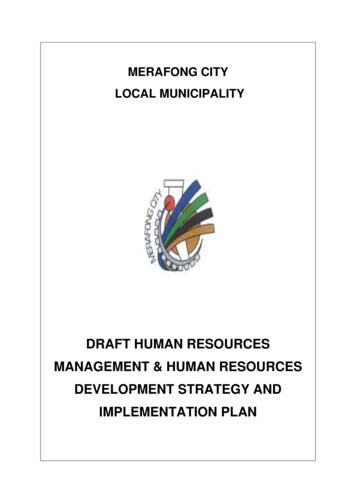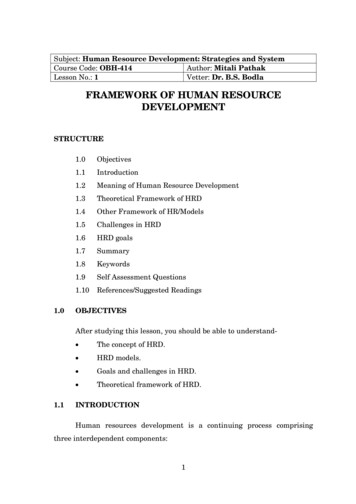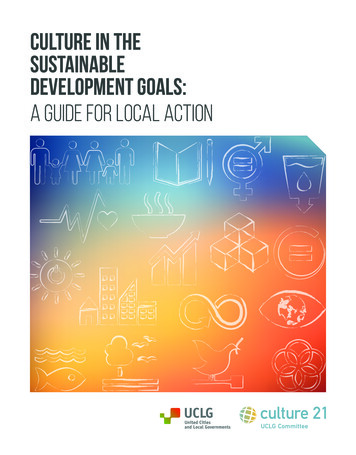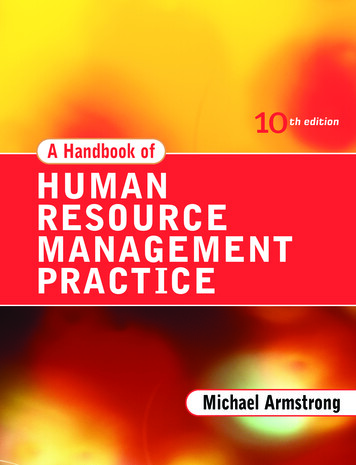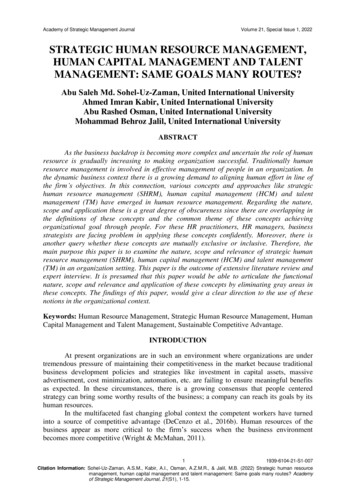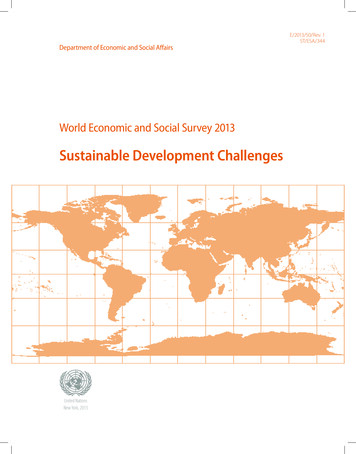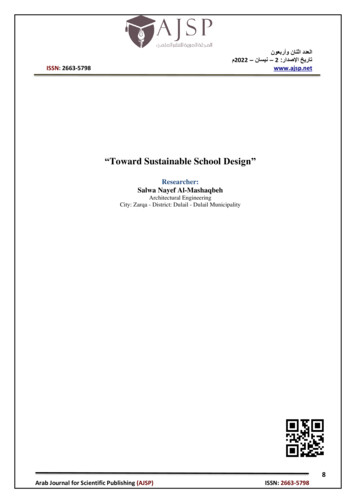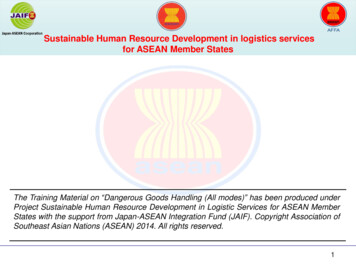
Transcription
Sustainable Human Resource Development in logistics servicesfor ASEAN Member StatesThe Training Material on “Dangerous Goods Handling (All modes)” has been produced underProject Sustainable Human Resource Development in Logistic Services for ASEAN MemberStates with the support from Japan-ASEAN Integration Fund (JAIF). Copyright Association ofSoutheast Asian Nations (ASEAN) 2014. All rights reserved.1
Sustainable Human Resource Development in logistics servicesfor ASEAN Member StatesIATA Dangerous Goods Regulations(IATA DGR)Mr. Chalermsak KarnchanawarinDangerous Goods HandlingChapter 4-2: IATA Dangerous Goods Regulations2
Sustainable Human Resource Development in logistics servicesfor ASEAN Member StatesIATA Dangerous Goods RegulationsObjectives: This chapter will cover the basic understanding on theapplicable transport regulation by Air (IATA DangerousGoods Regulations : IATA DGR) The Background, Development and Principles of IATA DGRwill be explained. Sections of IATA DGR will be briefly elaborated. It covers Basic Hazard Classification and HazardCommunication under IATA DGR.Dangerous Goods HandlingChapter 4-2: IATA Dangerous Goods Regulations3
Sustainable Human Resource Development in logistics servicesfor ASEAN Member StatesIATA Dangerous Goods RegulationsObjectives: The core element of the IATA DGR will be explained on how toread the information in Blue Pages (4.2 DG List) The Training Requirements under IATA DGR will beexplained. The example of how to use IATA DGR will also bedemonstrated.Dangerous Goods HandlingChapter 4-2: IATA Dangerous Goods Regulations4
Sustainable Human Resource Development in logistics servicesfor ASEAN Member StatesIATA Dangerous Goods RegulationsPresentation Outline IATA Dangerous Goods Regulations Background of IATA DGR Development of IATA DGR Principles of IATA DGR Identification of Dangerous Goods by Air Packaging as Essential Component of DG Transport Sections and Layout of Sections in IATA DGR IATA DG Classification IATA DG Hazard and Handling Labels Understanding the Blue Pages (4.2 DG List)Dangerous Goods HandlingChapter 4-2: IATA Dangerous Goods Regulations5
Sustainable Human Resource Development in logistics servicesfor ASEAN Member StatesIATA Dangerous Goods RegulationsPresentation Outline How to use IATA DGR Shipper’s Declaration for Dangerous Goods (DGD) Training Requirements Using IATA DGRDangerous Goods HandlingChapter 4-2: IATA Dangerous Goods Regulations6
Sustainable Human Resource Development in logistics servicesfor ASEAN Member StatesIATA Dangerous Goods RegulationsIATA Dangerous GoodsRegulationsIATA DGR“The Guide Recognized bythe World’s Airlines”55th EditionIssued year: 2014Dangerous Goods HandlingChapter 4-2: IATA Dangerous Goods Regulations7
Sustainable Human Resource Development in logistics servicesfor ASEAN Member StatesBackground of IATA DGR To provide procedures for the shipper and operator by which thearticles and substances with hazardous properties can be safelytransported by air on all air commercial transport. In 1953, the Member airlines of IATA recognized the growingneed to transport by air, article and substances havinghazardous properties which, if uncontrolled, could adversely affectthe safety of the passengers, crew and/or aircraft on which they arecarried. Most such articles and substances could be carried safelyprovided that they were properly packed and the quantities ineach packages were properly limited.Dangerous Goods HandlingChapter 4-2: IATA Dangerous Goods Regulations8
Sustainable Human Resource Development in logistics servicesfor ASEAN Member StatesDevelopment of IATA DGR The first version was published in 1956 as the IATA RestrictedArticles Regulations A Manual of Industry Carrier Regulations to be followed by all IATAmember airlines Latest edition is 55th Edition with effective 1st January – 31stDecember 2014 Published by the IATA Dangerous Goods BoardsDangerous Goods HandlingChapter 4-2: IATA Dangerous Goods Regulations9
Sustainable Human Resource Development in logistics servicesfor ASEAN Member StatesPrinciples of IATA DGRThe IATA DGR is an easy-to-use manual based on theInternational Civil Aviation Organization (ICAO) TechnicalInstructions for the Safe Transport of Dangerous Goods by Air Incorporates additional operational requirements, which provideharmonized system for operators to accept and transport dangerous goodssafely and efficiently Includes a detailed list of individual articles and substances specifying theUnited Nations classification of each article or substance and theiracceptability as well as the conditions for air transport.Dangerous Goods HandlingChapter 4-2: IATA Dangerous Goods Regulations10
Sustainable Human Resource Development in logistics servicesfor ASEAN Member StatesIdentification of Dangerous Goods by Air Forbidden under any circumstances Forbidden under normal circumstances but may be carriedwith specific approvals from the States concerned. Restricted to carriage on all cargo aircraft (CAO) Can be carried on passenger aircraft provided certainrequirements are met.Dangerous Goods HandlingChapter 4-2: IATA Dangerous Goods Regulations11
Sustainable Human Resource Development in logistics servicesfor ASEAN Member StatesPackaging as Essential Component of DG Transport Packing Instructions (PI) are provided with a wide range ofoptions (inner, outer, single packagings) Normally requires the use of UN performance-testedspecification packagings except when shipped in LimitedQuantity (“Y” Packing Instructions) The quantity of dangerous goods permitted within thesepackaging is strictly limited as to minimize the risk should anaccident occur.Dangerous Goods HandlingChapter 4-2: IATA Dangerous Goods Regulations12
Sustainable Human Resource Development in logistics servicesfor ASEAN Member StatesSections in IATA DGR Section 1: Applicability Section 2: Limitations Section 3: Classification Section 4: Identification (Blue pages) Section 5: Packing Section 6: Packing Specifications and Performance Tests Section 7: Marking and Labelling Section 8: Documentation Section 9: HandlingDangerous Goods HandlingChapter 4-2: IATA Dangerous Goods Regulations13
Sustainable Human Resource Development in logistics servicesfor ASEAN Member StatesSections in IATA DGR Section 10: Radioactive Materials Appendices A: Glossary Appendices B: Nomenclature (symbols, units & conversion tables) Appendices C: Currently assigned Substances (Div 4.1& 5.2) Appendices D: IATA Members, Associate Members and other Airlines Appendices E: Competent Authorities Appendices G: Related Services Appendices H: IATA Safety Standard Programmes IndexDangerous Goods HandlingChapter 4-2: IATA Dangerous Goods Regulations14
Sustainable Human Resource Development in logistics servicesfor ASEAN Member StatesLayout of Sections in IATA DGREach Section is further divided into numbered Subsections andparagraphs.1.3.3.2.1 raph13321(1)(1.3)(1.3.3)(1.3.3.2)(1.3.3.2.1)Table 3.3ASectionSubsection1st Table33A(3)(3.3)(3.3A)Dangerous Goods HandlingChapter 4-2: IATA Dangerous Goods Regulations15
Sustainable Human Resource Development in logistics servicesfor ASEAN Member StatesIATA DG Classification Class 1 - Explosives Class 2 - Gases Class 3 - Flammable liquids Class 4 - Flammable solids Class 5 - Oxidizing substances and organic peroxides Class 6 - Toxic and infectious substances Class 7 - Radioactive material Class 8 - Corrosive substances Class 9 - Miscellaneous dangerous substances and articlesDangerous Goods HandlingChapter 4-2: IATA Dangerous Goods Regulations16
Sustainable Human Resource Development in logistics servicesfor ASEAN Member StatesIATA DG Hazard and Handling LabelsDangerous Goods HandlingChapter 4-2: IATA Dangerous Goods Regulations17
Sustainable Human Resource Development in logistics servicesfor ASEAN Member StatesUnderstanding the Blue Pages (4.2 DG List)Column A UN No. - contains the serial number assigned to the article or substanceunder United Nations Classification System. When this number is used,it must be prefixed by the letters “UN”.Column B Proper Shipping Name (PSN)/Description - contains alphabeticallisting of dangerous goods articles and substances identified by theirproper shipping names together with qualifying descriptive text. Theproper shipping name is shown in bold (dark) type whereas thedescriptive text is shown in light type.Column C Class or division - contains the class or division number assigned tothe article or substance according to the classification system describedin Section 3. In the case of Class 1 Explosives, the compatibility groupis also shown.Dangerous Goods HandlingChapter 4-2: IATA Dangerous Goods Regulations18
Sustainable Human Resource Development in logistics servicesfor ASEAN Member StatesUnderstanding the Blue Pages (4.2 DG List)Column DSubsidiary Risks - contains the class or division number of anyimportant subsidiary risks. All subsidiary risks are listed in numericalorder.Column ELabels - contains the hazard label(s) to be applied to the outside of eachpackage and overpack for the commodity shown in Column B. Theprimary hazard label is listed first followed by any subsidiary risk label(s)Column FPacking Group - contains the UN Packing Group (I, II, III) whereassigned to the article or substance.Dangerous Goods HandlingChapter 4-2: IATA Dangerous Goods Regulations19
Sustainable Human Resource Development in logistics servicesfor ASEAN Member StatesUnderstanding the Blue Pages (4.2 DG List)Column GPassenger and Cargo Aircraft Limited Quantity – PackingInstructions – refers to the relevant Limited Quantity (Y) PackingInstructions listed in Section 5 for transport of the article orsubstance on a passenger or on a cargo aircraft. If no packinginstruction is shown, the article or substance cannot be carriedunder Limited Quantity provisions.Column HPassenger and Cargo Aircraft Limited Quantity – Maximum NetQuantity per Package – shows the maximum net quantity (weightor volume) of the article or substance allowed in each package fortransport on a passenger or cargo aircraft. The weight quoted is netweight, unless otherwise indicated by a letter G which refers to thegross weight of the package.Dangerous Goods HandlingChapter 4-2: IATA Dangerous Goods Regulations20
Sustainable Human Resource Development in logistics servicesfor ASEAN Member StatesUnderstanding the Blue Pages (4.2 DG List)Column IPassenger and Cargo– Packing Instructions – refers to therelevant Packing Instructions listed in Section 5 for transport of thearticle or substance on a passenger or on a cargo aircraft.Column JPassenger and Cargo Aircraft – Maximum Net Quantity perPackage – shows the maximum net quantity (weight or volume) ofthe article or substance allowed in each package for transport on apassenger or cargo aircraft. The weight quoted is net weight,unless otherwise indicated by a letter G which refers to the grossweight of the package.If the word “Forbidden” is shown, the article cannot be carried on apassenger aircraft.Dangerous Goods HandlingChapter 4-2: IATA Dangerous Goods Regulations21
Sustainable Human Resource Development in logistics servicesfor ASEAN Member StatesUnderstanding the Blue Pages (4.2 DG List)Column KCargo Aircraft Only– Packing Instructions – refers to the relevantPacking Instructions listed in Section 5 for transport of the article orsubstance on a cargo aircraft ONLY.Column LCargo Aircraft Only – Maximum Net Quantity per Package –shows the maximum net quantity (weight or volume) of the article orsubstance allowed in each package for transport on a cargo aircraftONLY. The weight quoted is net weight, unless otherwise indicatedby a letter G which refers to the gross weight of the package.If the word “Forbidden” is shown, the article cannot be carried onany aircraft unless exempted by States under the provisions of2.6.1.Dangerous Goods HandlingChapter 4-2: IATA Dangerous Goods Regulations22
Sustainable Human Resource Development in logistics servicesfor ASEAN Member StatesUnderstanding the Blue Pages (4.2 DG List)Column MSpecial Provisions – may show a single, double or triple digitnumber preceded by the letter “A”, against appropriate entries in theList of Dangerous Goods. This alpha-numeric indicator relates toSubsection 4.4 and applies to all the packing groups permitted forthe entry concerned, unless the wording of the special provisionmakes it otherwise apparent.Column NERG Code – Emergency Response Drill Code as found in theInternational Civil Aviation Organization (ICAO) document “TheEmergency Response Guidance for Aircraft Incidents InvolvingDangerous Goods”. The code consists of a combination of lettersand numbers, which represents suggested responses to incidentsinvolving the specific dangerous good entry to which the drill code isassigned.Dangerous Goods HandlingChapter 4-2: IATA Dangerous Goods Regulations23
Sustainable Human Resource Development in logistics servicesfor ASEAN Member StatesStates and Operators VariationStates and Operators Variations – entries in the List of DangerousGoods are subject to State and/or operator variations which mustalways be consulted.Variations are indicated in the appropriate locations in theseRegulations and described in Subsection 2.9.Dangerous Goods HandlingChapter 4-2: IATA Dangerous Goods Regulations24
Sustainable Human Resource Development in logistics servicesfor ASEAN Member StatesHow to use IATA DGRStep 1 Determine the correct technical names andcheck if forbidden.2.1 and 4.2Step 2 Check if it is listed in Blue Pages (4.2) andidentify PSN4.2Step 3 If not listed, determine class or division by itsknown properties3Step 4 If properties are not known, test should becarried outStep 5 If it has multiple hazards, refer to Subsection3.10 and check if forbidden.Dangerous Goods Handling3.10, 2.1, 4.2Chapter 4-2: IATA Dangerous Goods Regulations25
Sustainable Human Resource Development in logistics servicesfor ASEAN Member StatesHow to use IATA DGRStep 6 Determine the most appropriate PSN of N.O.S.entries4.1Step 7 If small quantities, check DG in exceptedquantities2.7Step 8 Desire to ship on passenger or cargo aircraftStep 9 Determine the Packing Instructions Number(PI) and check applicable States & OperatorsVariations Passenger aircraft (Column G & I) Cargo aircraft (Colum K & L)Dangerous Goods Handling4.2 and 2.9Chapter 4-2: IATA Dangerous Goods Regulations26
Sustainable Human Resource Development in logistics servicesfor ASEAN Member StatesHow to use IATA DGRStep 10 Determine the packing details in Section 5 andspecial requirements in Section 1 & 4.4.1Step 11 Select method of packing from PI. Ascertainall criteria are met.5.0 and 6Step 12 Ascertain all States and Operators Variationsare fully complied.2.9Step 13 Ensure all appropriate markings andlabellings are affixed on the packages7Dangerous Goods HandlingChapter 4-2: IATA Dangerous Goods Regulations27
Sustainable Human Resource Development in logistics servicesfor ASEAN Member StatesHow to use IATA DGRStep 14Complete and sign Shipper’s Declaration forDangerous Goods (DGD) and prepare AirWaybillStep 15Use checklist to recheckStep 16Offer the complete consignment for transportby airDangerous Goods Handling8Chapter 4-2: IATA Dangerous Goods Regulations28
Sustainable Human Resource Development in logistics servicesfor ASEAN Member StatesShipper’s Declaration for Dangerous Goods (DGD)Dangerous Goods HandlingChapter 4-2: IATA Dangerous Goods Regulations29
Sustainable Human Resource Development in logistics servicesfor ASEAN Member StatesTraining Requirements Training must be provided or verified upon the employment ofpersonnel identified in the categories specified in Table 1.5A Recurrent training must take place within 24 months of previoustraining to ensure knowledge is current, unless a competentauthority has defined a shorter period. A test must be undertaken following dangerous goods trainingto verify understanding of the regulations. Confirmation is requiredof successful completion of the test.Dangerous Goods HandlingChapter 4-2: IATA Dangerous Goods Regulations30
Sustainable Human Resource Development in logistics servicesfor ASEAN Member StatesTraining RequirementsDangerous Goods HandlingChapter 4-2: IATA Dangerous Goods Regulations31
Sustainable Human Resource Development in logistics servicesfor ASEAN Member StatesTraining RequirementsDangerous Goods HandlingChapter 4-2: IATA Dangerous Goods Regulations32
Sustainable Human Resource Development in logistics servicesfor ASEAN Member StatesUsing IATA DGR – The Blue Pages (4.2)Dangerous Goods HandlingChapter 4-2: IATA Dangerous Goods Regulations33
Sustainable Human Resource Development in logistics servicesfor ASEAN Member StatesUsing IATA DGR – Packing InstructionDangerous Goods HandlingChapter 4-2: IATA Dangerous Goods Regulations34
Sustainable Human Resource Development in logistics servicesfor ASEAN Member StatesUsing IATA DGR – Packing InstructionDangerous Goods HandlingChapter 4-2: IATA Dangerous Goods Regulations35
Sustainable Human Resource Development in logistics servicesfor ASEAN Member StatesUsing IATA DGR – Packing InstructionDangerous Goods HandlingChapter 4-2: IATA Dangerous Goods Regulations36
Sustainable Human Resource Development in logistics servicesfor ASEAN Member StatesUsing IATA DGR – States & Operators VariationsDangerous Goods HandlingChapter 4-2: IATA Dangerous Goods Regulations37
Sustainable Human Resource Development in logistics servicesfor ASEAN Member StatesUsing IATA DGR – States & Operators VariationsDangerous Goods HandlingChapter 4-2: IATA Dangerous Goods Regulations38
Sustainable Human Resource Development in logistics servicesfor ASEAN Member StatesIATA Dangerous Goods Regulations(IATA DGR)Mr. Chalermsak KarnchanawarinDangerous Goods HandlingChapter 4-2: IATA Dangerous Goods Regulations39
applicable transport regulation by Air (IATA Dangerous Goods Regulations : IATA DGR) The Background, Development and Principles of IATA DGR will be explained. Sections of IATA DGR will be briefly elaborated. It covers Basic Hazard Classification and Hazard Communication under IATA DGR. Chapter 4-2: IATA Dangerous Goods Regulations

